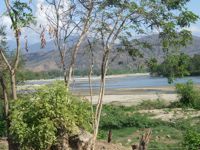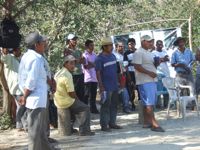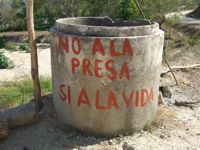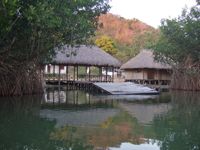Paso de la Reyna Dam Faces Opposition
We had seen the writing on the walls in the countryside around Jamiltepec — No a la presa [dam] Paso de la Reyna — and we thought we’d check it out. The dirt road to Paso de la Reyna begins in El Humedal, a village on the Coastal Highway, just south of Jamiltepec. After a half hour we reached Huichicata and were directed to an unmarked road that lead to Paso de la Reyna. It was February and the land was parched, but as we approached the Rio Verde, the cornfields and pastures kept getting greener and greener. The winding river was slow and majestic in the hidden valley. Then we came to a bridge with a wire strung across it and were ordered to stop by a group of villagers. We had arrived at the entrance to Paso de la Reyna.
The future of the Rio Verde may or may not be in the hands of the communities and environmental groups opposed to the massive hydroelectric project - including two dams - but the farmers standing guard were determined not to allow any CFE (the federal electric company) engineers onto their land.
It’s strange to think that 500 years after the conquest, in a valley that had no precious metals and was unsuitable for coffee plantations, the region had suddenly acquired an enormous value: one billion dollars in public and private, national and international investment is at stake.
Besides being opposed by the natives of Paso de la Reyna and some of the neighboring communities which would also be affected - either by their land being submerged by a reservoir or by the channeling of the Rio Verde - the project has also raised concerns in Chacahua where the mangroves are fed by the river.
It’s not surprising that the dam has become a cause celebre among national and international environmental groups, but the Bishop of Puerto Escondido took the unprecedented step of opposing the project on religious grounds through a pronouncement issued by the Dioceses of Puerto Escondido in 2009. Among other concerns, the Bishop’s statement notes that the dam will impact the climate and the flora and fauna of the region through changes in the water temperature and in the natural flow of the river and that it would harm the indigenous communities of the region.
Indigenous communities, the Bishop says, would not only lose their land but also the social fabric which binds them. Furthermore, according to the statement, the workers and their families who would be brought in could not easily be absorbed by the surrounding cities, and would be forced to live in impoverished neighborhoods lacking infrastructure and services.
Finally the pronouncement lists four dams that burst in Mexico in 2008 causing major destruction.
Meanwhile, the CFE continues to meet with the local communities, offering to improve the standard of living by providing clean drinking water, sewage, and health clinics, among other incentives. It also says that the project will create thousands of new jobs, although the region’s subsistence farmers can hardly be expected to be employed as heavy equipment operators.
We will keep you updated as the story unfolds.
by Barbara Joan Schaffer with Paola Arnaut














